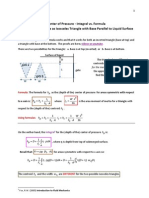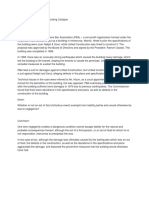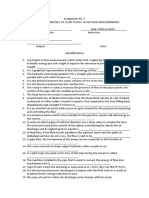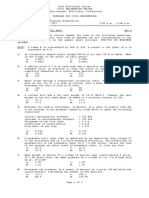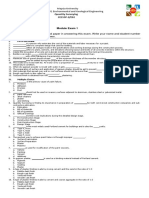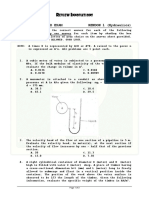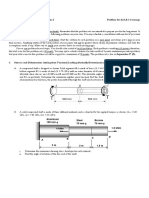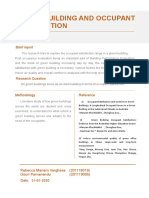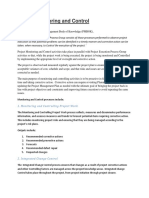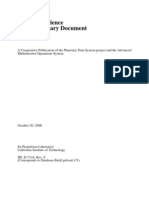Time Cost Trade Off PDF
Time Cost Trade Off PDF
Uploaded by
Rebecca MariamCopyright:
Available Formats
Time Cost Trade Off PDF
Time Cost Trade Off PDF
Uploaded by
Rebecca MariamOriginal Title
Copyright
Available Formats
Share this document
Did you find this document useful?
Is this content inappropriate?
Copyright:
Available Formats
Time Cost Trade Off PDF
Time Cost Trade Off PDF
Uploaded by
Rebecca MariamCopyright:
Available Formats
PROJECT TIME-COST TRADE-OFF
Activity durations can often vary depending upon the type and amount of resources that are applied.
Assigning more workers to a particular activity will normally result in a shorter duration. Greater speed
may result in higher costs and lower quality. Reducing both construction projects cost and time is
critical in todays market-driven economy. This relationship between construction projects time and
cost is called time-cost trade-off decisions, which has been investigated extensively in the construction
management literature. Time-cost trade-off decisions are complex and require selection of appropriate
construction method for each project task. Time-cost trade-off, in fact, is an important management
tool for overcoming one of the critical path method limitations of being unable to bring the project
schedule to a specified duration.
Time-Cost Trade-Off
The objective of the time-cost trade-off analysis is to reduce the original project duration, determined
form the critical path analysis, to meet a specific deadline, with the least cost.
In addition to that it might be necessary to finish the project in a specific time to:
1. Finish the project in a predefined deadline date.
2. Recover early delays.
3. Avoid liquidated damages.
4. Free key resources early for other projects.
5. Avoid adverse weather conditions that might affect productivity.
6. Receive an early completion-bonus.
7. Improve project cash flow
Reducing project duration can be done by adjusting overlaps between activities or by reducing activities
duration. What is the reason for an increase in direct cost as the activity duration is reduced? A simple
case arises in the use of overtime work. By scheduling weekend or evening work, the completion time
for an activity as measured in calendar days will be reduced. However, extra wages must be paid for
such overtime work, so the cost will increase. Also, overtime work is more prone to accidents and
quality problems that must be corrected, so costs may increase. The activity duration can be reduced by
one of the following actions:
1. Applying multiple-shifts work.
2. Working extended hours (over time).
3. Offering incentive payments to increase the productivity.
4. Working on week ends and holidays.
5. Using additional resources.
6. Using materials with faster installation methods.
7. Using alternate construction methods or sequence.
8.2 Activity Time-Cost Relationship
In general, there is a trade-off between the time and the direct cost to complete an activity; the less
expensive the resources, the larger duration they take to complete an activity. Shortening the duration
on an activity will normally increase its direct cost which comprises: the cost of labor, equipment, and
material. It should never be assumed that the quantity of resources deployed and the task duration are
inversely related. Thus one should never automatically assume that the work that can be done by one
man in 16 weeks can actually be done by 16 men in one week.
A simple representation of the possible relationship between the duration of an activity and its direct
costs appears in Figure 8.1. Considering only this activity in isolation and without reference to the
project completion deadline, a manager would choose a duration which implies minimum direct cost,
called the normal duration. At the other extreme, a manager might choose to complete the activity in
the minimum possible time, called crashed duration, but at a maximum cost.
The linear relationship shown in the Figure 8.1 between these two points implies that any intermediate
duration could also be chosen. It is possible that some intermediate point may represent the ideal or
optimal trade-off between time and cost for this activity. The slope of the line connecting the normal
point (lower point) and the crash point (upper point) is called the cost slope of the activity. The slope of
this line can be calculated mathematically by knowing the coordinates of the normal and crash points.
Cost slope = crash cost normal cost / normal duration crash duration
As shown in Figures 8.1, 8.2, and 8.3, the least direct cost required to complete an activity is called the
normal cost (minimum cost), and the corresponding duration is called the normal duration. The shortest
possible duration required for completing the activity is called the crash duration, and the corresponding
cost is called the crash cost. Normally, a planner start his/her estimation and scheduling process by
assuming the least costly option
You might also like
- Grabar Christian Iconography A Study of Its Origins by Andre Grabar Intro and Part I With IllustrationsDocument78 pagesGrabar Christian Iconography A Study of Its Origins by Andre Grabar Intro and Part I With IllustrationsMaryam Sita100% (3)
- Travel and Tourism IGCSE Scheme of WorkDocument41 pagesTravel and Tourism IGCSE Scheme of WorkEduardoMontuani100% (4)
- Math and Science For Young Children 8th Edition Charlesworth Test Bank 1Document14 pagesMath and Science For Young Children 8th Edition Charlesworth Test Bank 1mary100% (76)
- 16Document1 page16Mark Ruby Opawon100% (1)
- xCE 3121L CMT LABORATORY - MIDTERM EXAMINATION PDFDocument3 pagesxCE 3121L CMT LABORATORY - MIDTERM EXAMINATION PDFJmee LaurestaNo ratings yet
- Beating The Financial Futures Mkts - Combining Small Biases Into Money Making Strategies - Collins 2006Document272 pagesBeating The Financial Futures Mkts - Combining Small Biases Into Money Making Strategies - Collins 2006omangann75% (4)
- Tourism in The Face of 21 Century ChallengesDocument10 pagesTourism in The Face of 21 Century ChallengesdangelogirlNo ratings yet
- An Introduction To Holistic Time ManagementDocument62 pagesAn Introduction To Holistic Time ManagementbmapiraNo ratings yet
- LFTD PanelDocument39 pagesLFTD PanelErnane RitaNo ratings yet
- HomeDocument59 pagesHomeyanamitakeshimaNo ratings yet
- A Submerged Isosceles Triangle: Center of Pressure and Area Moment of InertiaDocument4 pagesA Submerged Isosceles Triangle: Center of Pressure and Area Moment of InertiaLinda Fahlberg-Stojanovska100% (2)
- Session 3 Kinetics of Particles Work Energy PrincipleDocument34 pagesSession 3 Kinetics of Particles Work Energy PrincipleRosina AdhikariNo ratings yet
- Comprehensive Exam - Mste (Solve Again)Document3 pagesComprehensive Exam - Mste (Solve Again)Ag OribianaNo ratings yet
- Engineering Economics Past BoardsDocument10 pagesEngineering Economics Past BoardsJinky OstanNo ratings yet
- SeatworkDocument7 pagesSeatworkRA KirongNo ratings yet
- Algebra Exam ContributionDocument2 pagesAlgebra Exam ContributionDan CasuraoNo ratings yet
- 620PT4032007 2008 2009 2010Document4 pages620PT4032007 2008 2009 2010Mona fabrigarNo ratings yet
- Review Innovations Evaluation Exam No. 1 Solution - 1Document10 pagesReview Innovations Evaluation Exam No. 1 Solution - 1Iris FloresNo ratings yet
- Ce ReferenceDocument1 pageCe ReferenceOwen Francis Arles MaongatNo ratings yet
- 100 MathDocument5 pages100 MathBen Matthew Alferez CoNo ratings yet
- Module 3Document10 pagesModule 3Niño YbañezNo ratings yet
- CE 314 AssignmentDocument6 pagesCE 314 AssignmentMathew YukaNo ratings yet
- OioiDocument5 pagesOioiSharaGailFuscabloNo ratings yet
- Ce4012 09Document26 pagesCe4012 09Durga SharmaNo ratings yet
- Ce Board 1Document18 pagesCe Board 1Ricardo DalisayNo ratings yet
- Two Compartments A and B Are Connected by An Orifice Having A 150Document4 pagesTwo Compartments A and B Are Connected by An Orifice Having A 150matthew cometaNo ratings yet
- Lec 18Document10 pagesLec 18Brian chunguliNo ratings yet
- ISU - Ilagan Module Foundation EngineeringDocument7 pagesISU - Ilagan Module Foundation EngineeringRanie boy CabanillaNo ratings yet
- Philippine Bar Association Building CollapseDocument2 pagesPhilippine Bar Association Building CollapseJohn Eric PinedaNo ratings yet
- For Online Practice Exam Visit Us atDocument12 pagesFor Online Practice Exam Visit Us atscribd scribdNo ratings yet
- Problem SetDocument2 pagesProblem Setmichael davidNo ratings yet
- Assignment in HydaraulicsDocument9 pagesAssignment in HydaraulicsJhona PancitoNo ratings yet
- Geotech - Topic 5 - Capillary Rise & Surface Tension - 14 Dec 2021Document7 pagesGeotech - Topic 5 - Capillary Rise & Surface Tension - 14 Dec 2021Lei TacangNo ratings yet
- Local Media3983018567083363738Document6 pagesLocal Media3983018567083363738Venus Kate GevaNo ratings yet
- CIE 128 - Lesson 4-5Document9 pagesCIE 128 - Lesson 4-5Daniel ColladoNo ratings yet
- Statistics: Measure of Central Tendency MeanDocument25 pagesStatistics: Measure of Central Tendency MeanjlNo ratings yet
- CE155P Module Exam 1Document4 pagesCE155P Module Exam 1Kelly Mae Viray100% (1)
- Math Samples PDFDocument1 pageMath Samples PDFArwin VillegasNo ratings yet
- Chapter 8 Exercise ProblemsDocument12 pagesChapter 8 Exercise ProblemsHalima Sibayan SawanganNo ratings yet
- HydraulicsDocument11 pagesHydraulicsMarvin BermidoNo ratings yet
- Eval 1 Review Nov 2020Document5 pagesEval 1 Review Nov 2020Shiela GonzalesNo ratings yet
- Refresher Exam 10 - MSTC Solution by Engr. MelvinDocument20 pagesRefresher Exam 10 - MSTC Solution by Engr. Melvingt201901573No ratings yet
- Problem Set 4Document4 pagesProblem Set 4Michael PantonillaNo ratings yet
- Problem 880 Moment Distribution MethodDocument2 pagesProblem 880 Moment Distribution MethodVirtual WizardNo ratings yet
- Correl Mock Hydraulics Set ADocument15 pagesCorrel Mock Hydraulics Set AMariah Kathleen LacsinaNo ratings yet
- Hydraulics: The Science of Hydraulics. Hydraulics Is Defined As That Branch of Science Which Treats ofDocument24 pagesHydraulics: The Science of Hydraulics. Hydraulics Is Defined As That Branch of Science Which Treats ofAj SobremonteNo ratings yet
- Ce 602 Compre 2023 2024Document7 pagesCe 602 Compre 2023 2024b.macahig.475608No ratings yet
- Local Media5124777314878222530Document6 pagesLocal Media5124777314878222530Joforce Karl MalanaNo ratings yet
- Preboard 3 Math Surveying With Answers Nov 2017 Set A 1Document3 pagesPreboard 3 Math Surveying With Answers Nov 2017 Set A 1Engr. Jobert S. De La CruzNo ratings yet
- Experiment 5 - FLUIDSDocument7 pagesExperiment 5 - FLUIDSJoeNo ratings yet
- Hydrau 1Document3 pagesHydrau 1Mayya BonaNo ratings yet
- Chapter 6Document31 pagesChapter 6Camille LardizabalNo ratings yet
- Permeability Test in The Field by Pumping From WellsDocument16 pagesPermeability Test in The Field by Pumping From WellsGed CudiamatNo ratings yet
- ES 13 1920A Problem Set 2Document5 pagesES 13 1920A Problem Set 2Charmaine ColetaNo ratings yet
- PipesDocument4 pagesPipesCamille Joy CucioNo ratings yet
- MODULE 2 PART 1 (Hydraulics)Document9 pagesMODULE 2 PART 1 (Hydraulics)Light HouseNo ratings yet
- Anghel A Open ChannelsDocument32 pagesAnghel A Open ChannelsJovan Bucol100% (1)
- Upang Cea 4bsce Cie095 P1Document54 pagesUpang Cea 4bsce Cie095 P1Wheng JNo ratings yet
- 1S1920 - SW - Fluid Mechanics: Name DateDocument12 pages1S1920 - SW - Fluid Mechanics: Name DateBosz' AceNo ratings yet
- Geotech Coaching 2Document13 pagesGeotech Coaching 2RODOLFO ARMEANo ratings yet
- Basic Elements of Transportation PlanningDocument3 pagesBasic Elements of Transportation Planningnouri100% (1)
- CM CH8 Time-CostDocument18 pagesCM CH8 Time-CostArok ANo ratings yet
- Cpm322e Ch5 Time-CostDocument18 pagesCpm322e Ch5 Time-Costpapilolo2008No ratings yet
- Project Time Cost Trade OffDocument35 pagesProject Time Cost Trade OffTEODORO AMATOSA JR.No ratings yet
- Crash with ConfidenceDocument8 pagesCrash with ConfidenceAmin KhanNo ratings yet
- Rebecca - Psa Sub 1Document22 pagesRebecca - Psa Sub 1Rebecca MariamNo ratings yet
- 19 PDFDocument1 page19 PDFRebecca MariamNo ratings yet
- Hoa - MesopotamianDocument17 pagesHoa - MesopotamianRebecca MariamNo ratings yet
- Hoa - Hindu ArchitectureDocument129 pagesHoa - Hindu ArchitectureRebecca Mariam50% (2)
- Flash Floods in Uttarakhand (S8-A) 2Document39 pagesFlash Floods in Uttarakhand (S8-A) 2Rebecca MariamNo ratings yet
- Pert Notes PDFDocument15 pagesPert Notes PDFRebecca MariamNo ratings yet
- Project Monitoring and Control Expediting PDFDocument5 pagesProject Monitoring and Control Expediting PDFRebecca MariamNo ratings yet
- The Far Horizons of Time Time and Mind in The Universe (2014)Document128 pagesThe Far Horizons of Time Time and Mind in The Universe (2014)yaoyansiNo ratings yet
- Bowling Practise: by Rob JudsonDocument9 pagesBowling Practise: by Rob JudsondarbilalahmadNo ratings yet
- Mechanical - Engineering - Computer Integrated Manufacturing Systems - Analysis of Automated Flow Line Line Balancing - Notes PDFDocument23 pagesMechanical - Engineering - Computer Integrated Manufacturing Systems - Analysis of Automated Flow Line Line Balancing - Notes PDFalok shagun2706No ratings yet
- Astro NavigationDocument308 pagesAstro Navigationlivlaser100% (3)
- XFlow TutorialGuide v1.0.82Document86 pagesXFlow TutorialGuide v1.0.82Mircea Bocioaga100% (4)
- Brian Tracy - Executive Time Management PDFDocument0 pagesBrian Tracy - Executive Time Management PDFscribdcheaterman75% (8)
- 11 Planetary Science Data DictionaryDocument582 pages11 Planetary Science Data DictionaryMarcus Skookumchuck VanniniNo ratings yet
- Instant Download Better Data Visualizations: A Guide For Scholars, Researchers, And Wonks Jonathan Schwabish PDF All ChaptersDocument55 pagesInstant Download Better Data Visualizations: A Guide For Scholars, Researchers, And Wonks Jonathan Schwabish PDF All Chapterstruebryliexn100% (6)
- Why Students Should Eat Breakfast EverydayDocument8 pagesWhy Students Should Eat Breakfast EverydayEarly Vici Azmia0% (1)
- Galaxy Writing Competition CorrectedDocument4 pagesGalaxy Writing Competition CorrectedAnonymous 7UCWo2No ratings yet
- ISE Statics and Mechanics of Materials (ISE HED MECHANICAL ENGINEERING) 3rd Edition Ferdinand P. Beer 2024 Scribd DownloadDocument66 pagesISE Statics and Mechanics of Materials (ISE HED MECHANICAL ENGINEERING) 3rd Edition Ferdinand P. Beer 2024 Scribd Downloadcolyoakodu100% (2)
- Research Proposal - Chapter 3 MethodologyDocument20 pagesResearch Proposal - Chapter 3 Methodologyroselyn espinosaNo ratings yet
- The Architecture of Narrative Time PDFDocument229 pagesThe Architecture of Narrative Time PDFAgria100% (1)
- Elements of Visual Design in The Landscape - 26.11.22Document15 pagesElements of Visual Design in The Landscape - 26.11.22Delnard OnchwatiNo ratings yet
- Importance of HistoryDocument1 pageImportance of HistoryRaine SamsonNo ratings yet
- IELTS Essays by Ngoc BachDocument11 pagesIELTS Essays by Ngoc BachTrần Văn Tâm100% (1)
- Manual de Usuario Procesadora de RX Protec Optimax 2010 (Inglés) PDFDocument52 pagesManual de Usuario Procesadora de RX Protec Optimax 2010 (Inglés) PDFJorgeLuis Anaya NúñezNo ratings yet
- A Two Stage Fuzzy Logic Adaptive Traffic Signal Control For An Isolated Intersection Based On Real Data Using SUMO SimulatorDocument4 pagesA Two Stage Fuzzy Logic Adaptive Traffic Signal Control For An Isolated Intersection Based On Real Data Using SUMO SimulatorEditor IJTSRDNo ratings yet
- Fdocuments - in - Recording Techniques Used in Method StudyDocument49 pagesFdocuments - in - Recording Techniques Used in Method StudyManash DeyNo ratings yet
- How We Shape Our Cities And, Then They Shape UsDocument8 pagesHow We Shape Our Cities And, Then They Shape UsPretzeliciousNo ratings yet
- Power of Our Words Journal EntriesDocument12 pagesPower of Our Words Journal Entriesapi-237787503No ratings yet
- English Unit 2.1 Draft TG PDFDocument28 pagesEnglish Unit 2.1 Draft TG PDFMa Marisa Arbalate100% (1)
- DEE MagazineRDocument70 pagesDEE MagazineRChirag ShahNo ratings yet
- Brother Veritus Website EnglishDocument49 pagesBrother Veritus Website Englishrog.linNo ratings yet










